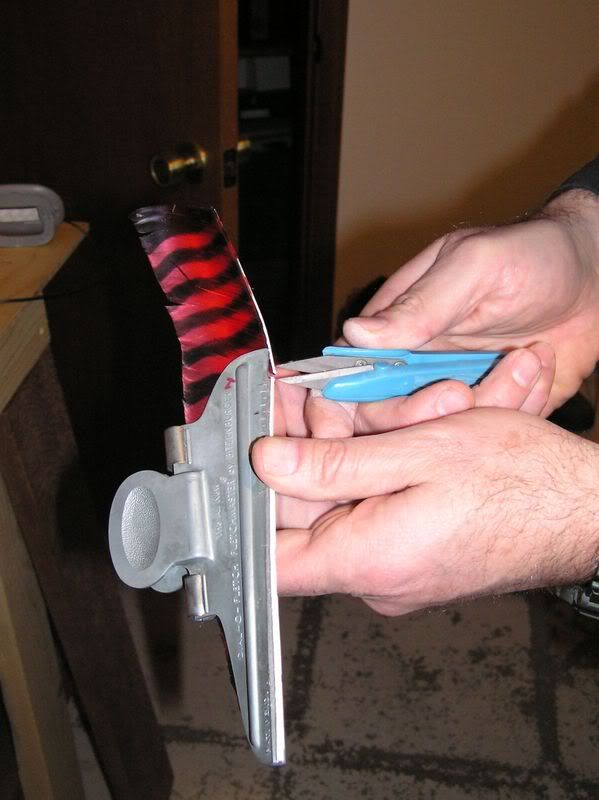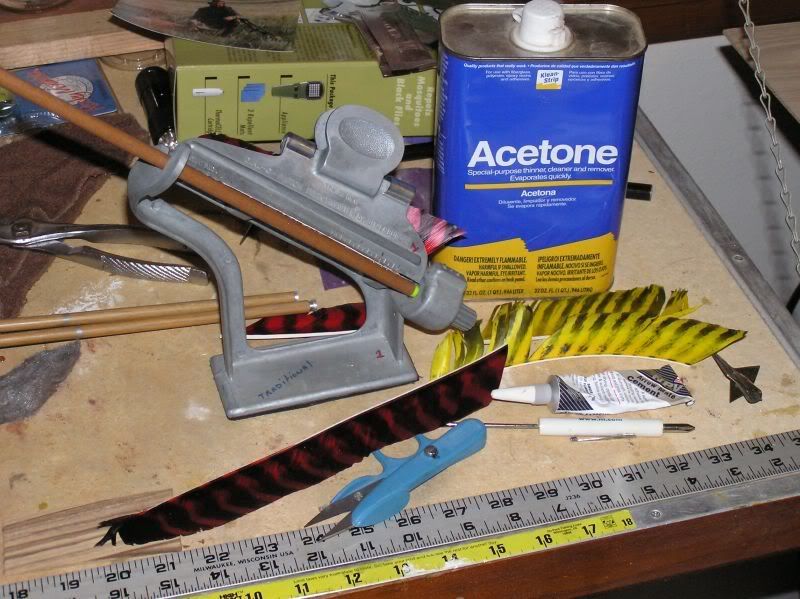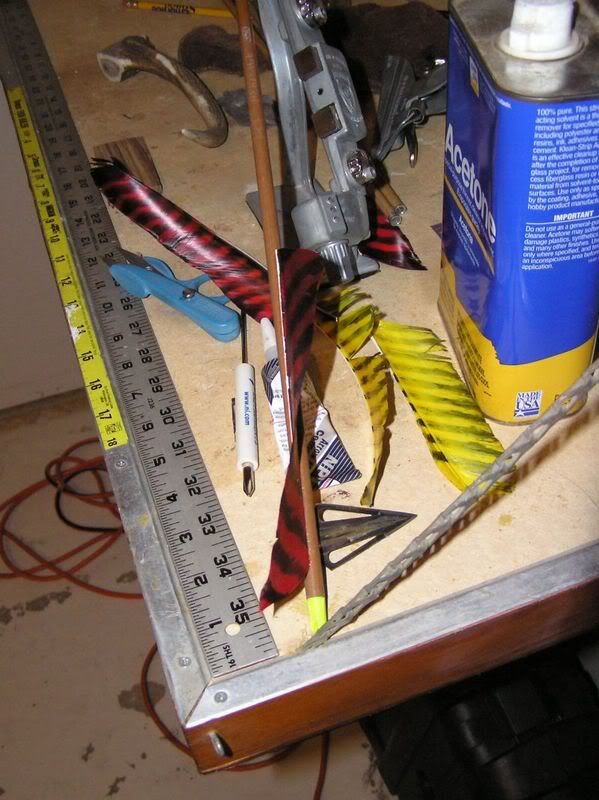|
|
Post by oldfarmsblueman on Dec 31, 2008 16:57:51 GMT -5
How will a Flu-Flu fly compaired to a regular carbon arrow with in 20-30 yard range?Are they carbon ? And can you make your own  And would you still need a blunt or judo point? |
|
|
|
Post by lockmaster on Dec 31, 2008 17:15:39 GMT -5
Flu-Flu is a type of arrow specifically designed to travel a short distance, Such arrows are particularly useful when shooting at aerial targets or for certain types of recreational archery where the arrow must not travel too far. To avoid getting lost if it misses the target.
Flu-Flu arrows were used originally to hunt birds (and still are). When taking aim at the bird the archer must lead the bird and release the arrow in anticipation of the bird's travel path. Because flu-flu arrows fly short distances, it is easy for the archer to recover the arrow if the target is missed. Special bird points are used that entangle the bird as it flies into a wire harness attached to the end of the arrow.
A flu-flu is a design of fletching, normally made by using long sections of feathers, in most cases six or more sections are used rather than the traditional three. Alternatively two long feathers can be spiraled around the end of the arrow shaft. In either case, the excessive fletching serves to generate more drag and slow the arrow down rapidly after a short distance, about 30m or so. Recreational flu-flus usually have rubber points in order to add weight in order to keep the flight slower.
Flu-Flu arrows are often used for children's archery, and can be used to play Flu-Flu Golf (where the player must go to where the arrow landed, and pick it up and shoot it again, and repeat this until he reaches a specified place).
|
|
smj
Forum Guide
  Traditional Council
Traditional Council
Posts: 1,819
|
Post by smj on Dec 31, 2008 22:13:56 GMT -5
Start with materials - wood or carbon, in this case carbon -  A shaft, uncut feathers with the quill split, glue, a little acetone, a fletching jig helps a lot, something sharp to scrape the old gunk off of used shafts (even an old broadhead works!). Scrape the shaft of glue left over from the last fletching, if needed, then wipe down with acetone to clean up nice. I next cut the feather to length, measured by the length of my jig. -  Then I clip it in to a straight jig, just to ease the holding of it, and grind the quill flat with a board and sandpaper. -  It helps to thin the shaft, or quill, of the feather, if you leave the quill thick, the feather can break right off if pressed on from the side. Thinner is best by my experience. Once thinned down, it is time for some glue and quality time on the jig. -  After the glue dries - I prefer long dry glue for this, I don't have a good reason other than I had some troubles with the quick dry stuff. Still, once it is dry, remove from the jig and go to the next fletch. Put a drop of glue off the ends of the fletch. It should look something like this -  Once you have 4 fletch mounted, it looks like this -  This one is with yellow fletching, it shows up better in photos! Note the quill is thick - these fletchings broke off through the quill with a little side pressure, so thin and smooth them with rough sandpaper - helps the glue stick as well. If you want more drag, mount four more fletch between the first ones... With a jig, you can do this. There are other means of making flu-flus - but this is the most accurate shooting flu-flu that I've built and used. You can expect a heavy arrow to shoot just about 100% normal for 20 yards. By 30 yards, you will start to see it drop, beyond 30 yards it drops like a rock! Please note - the arrow will still go a long ways! A bit of trial and experiment is a good idea. A lighter shaft will show greater influence to the breaking action of the flu-flu fletching. Flu-flu's built by wrapping a standard fletch around the shaft work, but I find them dismal when it comes to accuracy. With use, the feather will start to break up a bit, separate along its length. This makes for a rougher surface, and the effect will be greater. If wanted, rub the feather backward, if you will, to rough up the feather right off, it will slow a bit faster. Nasty, ratty fletching is slower shooting fletching. You can put any tip you want on it, use wood, aluminum, or carbon shafts. A drop away rest is very friendly to this type of fletching - other arrow rests are not so kind and can rip them up rather quickly. Note that if the rest chews up the fletching, accuracy will suffer as well. All the rules of archery still apply, smooth release and the least contact to the bow/rest upon release is required for accuracy! The good news is that it not a huge job to redo them when that time comes around! Hope that helps! |
|
|
|
Post by oldfarmsblueman on Jan 1, 2009 8:35:52 GMT -5
smj--- Great post ::)I will get some larger feathers and
make some this spring. THANKS OFB
|
|
|
|
Post by BT on Jan 1, 2009 14:56:54 GMT -5
Nice SMJ  |
|
|
|
Post by Buckshot06 on Jan 1, 2009 17:34:30 GMT -5
smj great pics and thanks for the post.
|
|
|
|
Post by pastorfarley on Jan 2, 2009 12:08:43 GMT -5
Great post SMJ!
I have just started experimenting with high twist Flu-Flu's where I have used standard 4" parabolic or 5"shield cut with each feather twisted 180 deg or 90 deg around the shaft. I am using a four feather fletch on Carbon Express Lites from Walmart to keep my costs down. I have tried a 125gr point and a 100gr point. I will probably end up with the 125 to increase arrow drop.
So far the results are promising, but the drop away rest is a good idea. It is obvious I will be replacing feathers and moleskin often on mine.
I have not shot them outside yet, but at ten yards they strike at point of aim for standard fletching. At 17 yards (my max range in the basement) they are low, about 2-3 inches, where my standard arrows are still point blank.
The 180 twist are quite noisy, the 90 less so. The penetration difference between the standard fletch, 90 and 180 is about 1" at each level of resistance.
I have tried them with a few broadheads and a vintage Bear Razorhead works fine, as does a 125 gr Vortex.
I am working on these for small game. I have three x-weaves somewhere on the church property and all were deflected off the dirt. Some may have reached the neighbors property and that is a safety issue, as well as being against the law in Maine.
|
|